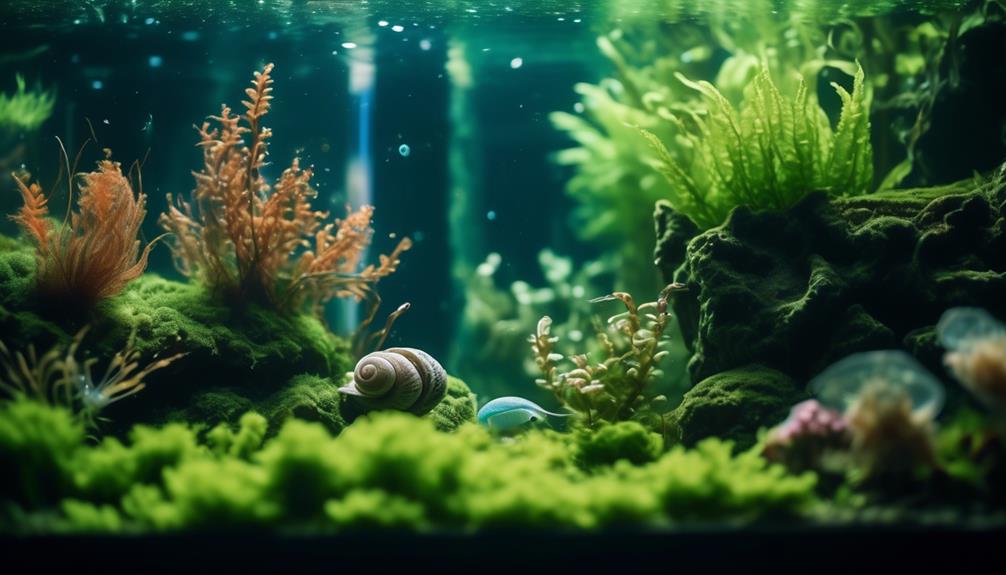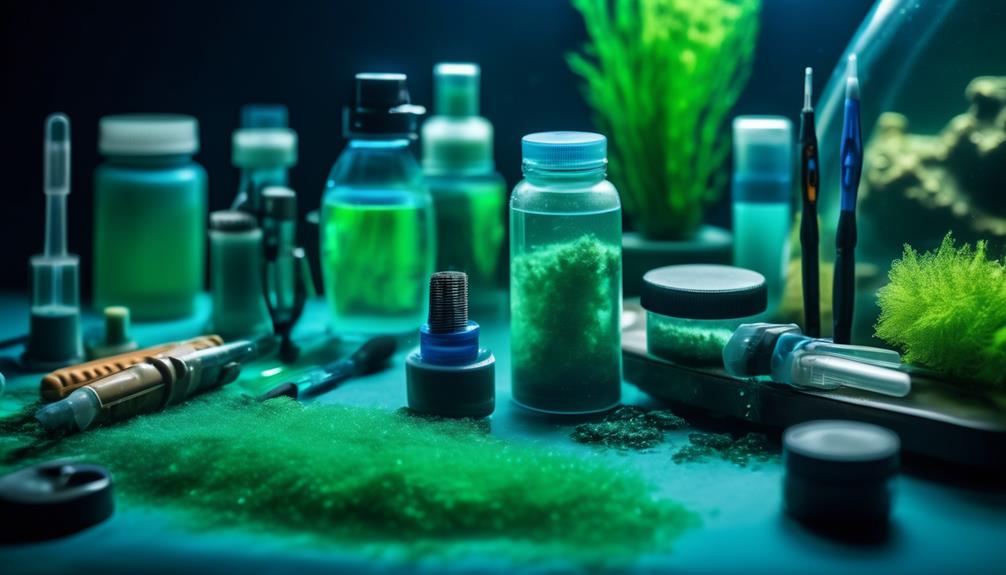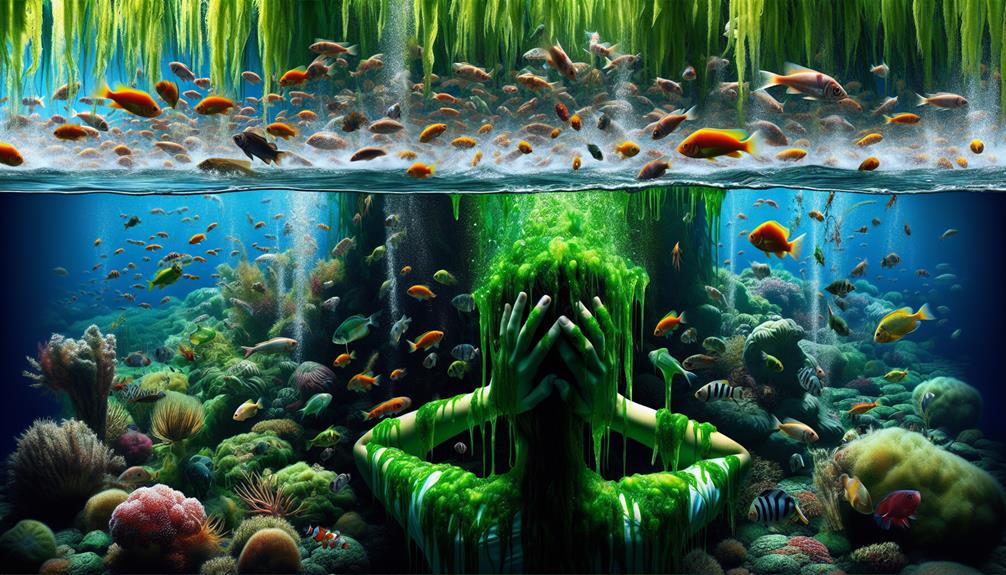Blue-green algae, often referred to as cyanobacteria, poses a significant threat to the health and aesthetics of your aquarium. Its vibrant blue-green color and slimy texture can quickly overtake your aquatic environment, compromising the well-being of your plants and disrupting the delicate balance of your tank.
In this discussion, we will explore the various causes of cyanobacteria blooms and delve into effective prevention and treatment strategies. By understanding the underlying factors and implementing targeted solutions, you can regain control over your aquarium and restore its natural beauty.
Stay tuned as we uncover the secrets to conquering this dreaded nightmare.
Key Takeaways
- Blue-green algae, also known as cyanobacteria, can be harmful to plants in aquariums by blocking their ability to photosynthesize.
- Cyanobacteria blooms in aquariums are often caused by stagnant water, excess nutrients, and accumulated debris in the substrate.
- Natural methods to get rid of blue-green algae include manual removal, reducing excess nutrients through water changes and filter cleaning, improving water flow, and adjusting aquarium lighting.
- Treatment options for cyanobacteria include using antibiotics like erythromycin or specific products like Fritz Slime Out, and multiple treatments may be necessary for severe outbreaks.
Understanding Blue-Green Algae
Blue-green algae, also known as cyanobacteria, is a type of photosynthetic bacteria that can form slimy colonies and have a detrimental impact on plants in aquariums. These bacteria have unique growth patterns, often appearing as thick slime that can cover surfaces and hinder the growth of plants.
Blue-green algae blooms occur in warm, slow-moving, and nutrient-rich water, which is commonly found in aquariums where organic waste stagnates. The presence of blue-green algae can have adverse effects on fish health. It can release toxins that can harm fish directly, leading to stress, decreased immune function, and even death. Additionally, the slimy colonies can clog fish gills, impairing their respiratory system.
It is crucial to address blue-green algae growth promptly to maintain a healthy and thriving aquarium ecosystem.
Causes of Cyanobacteria in Aquariums
Cyanobacteria blooms in aquariums are primarily caused by the presence of warm, slow-moving, and nutrient-rich water. These conditions create an ideal environment for the growth and proliferation of cyanobacteria. In aquariums, cyanobacteria often appear in areas where organic waste stagnates, such as in the substrate or on decorations. Slow water flow and constant light in certain areas also promote cyanobacteria growth.
Preventing cyanobacteria growth is essential to maintaining a healthy aquarium environment. Regular maintenance, such as frequent water changes and cleaning the filter, helps remove excess nutrients that can fuel cyanobacteria growth. Improving water flow with a stronger filter or powerhead, and rearranging decorations to prevent stagnant areas, can also be effective.
It is important to note that cyanobacteria can have detrimental effects on fish health. It can release toxins that harm fish and other aquatic organisms. Additionally, cyanobacteria blooms can deplete oxygen levels in the water, leading to stress and suffocation for fish. Therefore, it is crucial to address cyanobacteria growth promptly and take measures to prevent its recurrence.
Natural Methods to Control Blue-Green Algae

To effectively control blue-green algae in aquariums, it is important to employ natural methods that target the underlying causes of its growth. Using chemicals should be a last resort, as they can disrupt the balance of the aquarium ecosystem.
Prevention is key when it comes to cyanobacteria. Manual removal of the slime using a siphon, toothbrush, or algae scraper is a simple yet effective method. Additionally, removing excess nutrients through frequent water changes and cleaning the filter can help reduce the conditions that promote cyanobacteria growth.
Reducing the amount of fish or food can also lower nutrient levels in the aquarium. Improving water flow with a stronger filter or powerhead, as well as rearranging decorations, can prevent stagnation and create an environment less favorable for cyanobacteria.
Careful consideration when turning off aquarium lighting can also be beneficial. By implementing these natural methods, aquarists can effectively control blue-green algae without relying on chemicals.
Treatment Options for Cyanobacteria
Treatment options for cyanobacteria in aquariums include the use of specific antibiotics and recommended products designed to effectively combat and eliminate the presence of this persistent algae. One such antibiotic is erythromycin, which has shown effectiveness in controlling cyanobacteria outbreaks. Additionally, there are various algae treatments available in the market that target cyanobacteria. To provide a clear comparison of these treatments, the following table illustrates their key features and benefits:
| Treatment | Key Features | Benefits |
|---|---|---|
| Erythromycin | Antibiotic medication | Effective against cyanobacteria |
| Fritz Slime Out | Recommended product specifically for cyanobacteria | Targets and treats cyanobacteria outbreaks |
| Other algae treatments | Varies depending on product | May have varying degrees of effectiveness |
It is important to note that before any treatment, it is advisable to manually remove as much cyanobacteria as possible. Additionally, multiple treatments may be necessary for severe outbreaks. By selecting the appropriate treatment and following the recommended procedures, aquarists can effectively combat cyanobacteria and restore a healthy environment for their aquarium inhabitants.
Additional Resources

After exploring the treatment options for cyanobacteria in aquariums, it is essential to equip aquarists with additional resources to effectively combat and prevent future outbreaks.
One important resource is a full guide on how to prevent blue-green algae in aquariums. This comprehensive guide provides detailed information on the common types of freshwater algae and offers valuable tips and strategies to prevent their growth. It outlines preventive measures such as maintaining proper water flow, regular water changes, and proper filtration to minimize nutrient buildup.
Additionally, aquarists can subscribe to a weekly aquarium blog that provides up-to-date articles on various aquarium topics, including algae control. These blog posts offer practical advice, insights, and solutions to help aquarists maintain a healthy and algae-free aquarium environment.
Furthermore, specific care guides for Zebra and Leopard Danios and Amano Shrimp can provide aquarists with species-specific information to ensure optimal care and minimize the risk of algae outbreaks.
Frequently Asked Questions
Can Blue-Green Algae Harm Fish or Other Aquatic Animals in the Aquarium?
Blue-green algae can harm fish and other aquatic animals in the aquarium by reducing oxygen levels, releasing toxins, and causing stress. Effective methods to control blue-green algae growth include manual removal, reducing nutrient levels, improving water flow, and using treatments like antibiotics or specialized products.
How Long Does It Typically Take for Blue-Green Algae to Form in an Aquarium?
Blue-green algae can form in aquariums within a few weeks to a few months, depending on environmental factors such as water temperature, nutrient levels, and light exposure. Regular maintenance and proper water management can help prevent its formation.
Can Blue-Green Algae Be Harmful to Humans if They Come Into Contact With It?
Blue-green algae can produce toxins that are harmful to humans if they come into contact with it. Precautions to take include avoiding direct contact, wearing protective gloves, and thoroughly washing hands and any contaminated items to prevent potential health effects.
Are There Any Specific Types of Fish or Plants That Are More Resistant to Blue-Green Algae?
There are certain fish and plants that have shown resistance to blue-green algae, such as Siamese algae eaters, Otocinclus catfish, and hornwort plants. These species can help control the growth of blue-green algae in an aquarium.
Is There a Way to Prevent Blue-Green Algae From Forming in the First Place?
Preventing blue-green algae formation in aquariums can be achieved through several natural remedies. These include maintaining proper water flow, reducing organic waste, controlling nutrient levels, and ensuring appropriate lighting conditions. Regular maintenance and good aquarium management practices are crucial.
Conclusion
In conclusion, blue-green algae poses a significant threat to the health and aesthetics of aquariums. Understanding the causes of cyanobacteria blooms is crucial for effective prevention and treatment.
By implementing natural methods such as manual removal, nutrient reduction, and improving water flow, aquarists can combat this invasive organism. In more severe cases, treatment options like antibiotics and specialized products like Fritz Slime Out may be necessary.
With the right knowledge and tools, aquarists can conquer the dreaded nightmare of blue-green algae and maintain a thriving aquatic environment.

